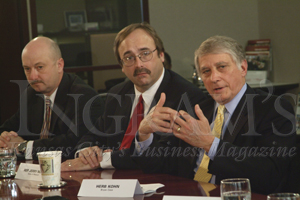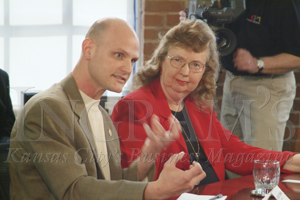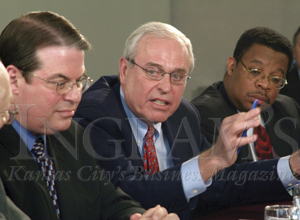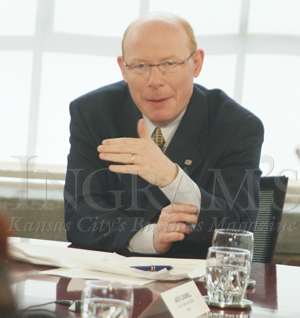
There’s Still Hope for the
Bi-State Concept
 To start the discussion, Haines asked the participants what their stake was in the issue. O’Connor, a senator who took the “no-tax” pledge, quickly got to the point that she did not like Bi-state II because of a loss of sovereignty for most of those involved.
To start the discussion, Haines asked the participants what their stake was in the issue. O’Connor, a senator who took the “no-tax” pledge, quickly got to the point that she did not like Bi-state II because of a loss of sovereignty for most of those involved.
Rep. Schwab agreed with O’Connor, though he wasn’t opposed to any tax increase, just one in which his constituents did not have a voice on the back end. He also suggested that there was not enough consideration for at least some of the tax money being spent in Kansas.
Rep. Nolte, whose district includes Gladstone, Claycomo and parts of Kansas City, agreed with Schwab’s assessment of a need for all regions to be represented in the governance of the money raised from a bi-state tax effort. “Just make sure there’s some accountability,” Nolte said. “With Bi-state II, Clay County had a stronger voice, which we appreciate.”
City Manager Cauthen’s issue with Bi-state II was pouring money into the Truman Sports Complex, a two-stadium facility that is approaching 35 years of age. Cauthen came to his role with the city two years ago from Denver, where he was chief of staff to Mayor Wellington Webb for the previous six years. He arrived in time to get immersed in the Bi-state II discussions.
Flaherty turned up the burners when he stated, “The opponents of Bi-state II did not win the election. The proponents lost it. They lost it because they were arrogant, they were greedy and they were dishonest in the way they went at it.”

Time to pull the plug?
After all the participants had their chance to state their stake in the struggle, Haines asked if, after the failure of the “Think Big” campaign, it was time to pull the plug on the entire bi-state concept.
citizens. When you put Kansas money into one pot and add some Missouri money to the same pot, and stir it all up, open records no longer are open records. Kansas law doesn’t apply and Missouri law doesn’t apply.”
Haines modified the question,and directed it at Craft, who chaired the effort on the Missouri side. “Was the failure of Bi-state II a failure of the bi-state concept?”
Craft said no, because polls and focus groups indicate that Kansans are not opposed to their tax dollars being used for metropolitan-wide assets, and neither are Missourians. “The difficulty is developing a pro-posal that satisfies everybody’s desire to have accountability,” Craft said
Byrne, who represented the arts community, said that the bi-state concept was necessary for Kansas City to reach the status its residents want it to have. “The state line is a factor, but we can’t let it inhibit the growth of regional assets such as the major cultural institutions that we have,” he said. He then blamed the failure of Bi-state II on the coupling of the arts with the stadium renovation.
“The voters have never been afforded the opportunity to vote on the Bi-state cultural tax as it was originally authorized-for the arts only and not for a single purpose (within the arts). We need to take it to the voters in a way that is compelling and answers the questions on the minds of the public.”
When asked by Haines if the arts community was resentful that it hadn’t occurred already, Byrne said no, but “We believe in the importance of arts and culture to this large metropolitan area and we want to see it go forward in a different form.”
Kansans Against Bi-state’s Flaherty implied that he agreed with Byrne that the two issues should not have been coupled. “We do not like the idea of having to support and subsidize billionaire sports team owners,” he said.
Uncoupling the two issues would not only settle the discussion once and for all, according to Rep. Schwab, it would be the death knell for an arts-only Bi-state. “The sports arenas are selling out,” he said. “With the arts, most of the arts community is in Missouri, so (Kansans) don’t want to invest in it. If we run a pure arts initiative for Bi-state, I don’t think you’re going to get any more voters out of Kansas until you generate an interest for that. And if you’re going to generate an interest for that, you have to build some arts com-munity on the Kansas side.”
That opened a spirited debate between Schwab and Byrne. Byrne retorted that 50 percent of the audience for the Kansas City Symphony comes from Kansas. “We see ourselves as a region-serving institution, and it’s our goal to serve all five major metropolitan counties.”
Schwab countered that that might be true, but the attendance numbers only account for part of the equation. He claimed that the raw numbers did not support the claim of equal interest. Byrne was not about to give up. “The Arts Council has determined that more people have attended a cultural event in the KC metropolitan area than have attended a live sports event, by a significant number. The fact that there’s not the same profile, is a function, in part, of the media and of any number of other things.”
“That’s what I’m saying,” Schwab responded. “When they go home, most people don’t watch the symphony on TV. If they want the symphony, they go to it live. But they can go home and watch ESPN or ESPN 2. They’re inundated with sports; they’re not with the arts. They may never go to a Chiefs game, but they’re going to watch them on TV every Sunday.”

The concept is not the problem
Herb Kohn, who lives in midtown and works downtown and supported both Bi-states, jumped in. “We need to separate two things,” he said. “It’s not the concept of Bi-state that’s the problem. The difference between I and II, in my opinion, is that in Bi-state I, there was a very clear, concise program that was presented to the people, the need to renovate and rebuild Union Station. The problem with Bi-state II, I think, was in the packaging. I think you’ve got to tell the people exactly what it is they’re voting for. If they’re voting for $50 million for the performing arts center, tell them that’s what it is.”
Jack Craft, who chaired the Missouri effort, acknowledged this flaw and stated that it was difficult to navigate. “The difficulty with this proposition is that it lasted longer than the first Bi-state and it was difficult to set in the ballot specifically how the money would be spent.”
He further stated that the arts community spent several years trying to resolve how the money would be distributed. They concluded that a bid process, a process with competitive bids that would permit entities from all over the metropolitan community to bid, was the best way. “It was not a sufficiently credible process to permit people to have comfort,” he said.
Craft also addressed Rep. Schwab’s assessment that Kansas voters wanted some of the arts “assets” on their side of the state line. “It is just not conceivable that the Nelson Gallery is going to be replicated in Olathe,” he said. “The reality is that there are certain assets in Kansas City, Missouri, that have to be supported by a metropolitan area of a million and a half people. If each of us provides assets that are sufficient for a community of 15,000 or 30,000, we lose the richness in our community that we all want.”
Schwab said it was not about Olathe, or any other city. In fact, “Downtown KCK has a rich history too, but we’re not trying to revitalize that area,” he said. Instead, the reason Bi-state II failed is that “Johnson County wants a voice at the table. We get frustrated when they tell us, ‘We want your money, but we don’t want your input.’”
City Manager Cauthen has heard that before, and he said that Kansas City, Missouri, specifically is trying to address the issue of Kansas input. But he also said that the metro area must realize that downtown Kansas City, Missouri, must be revitalized for the entire metro to be viewed as vibrant.“That’s what people look at when they come to a metropolitan area,” he adds.

What have we learned?
KCPT’s Haines asked Rep. Nolte what lessons had been learned from Bi-state II. Nolte said that besides the complexity of the ballot issue, that all three major areas-Kansas, Jackson County, and the Northland-must be represented and have their needs met. When Haines asked him if Bi-state II helped people in his constituency-north of the river-Nolte said, “If there was a gain to be had, it wasn’t communicated.
Jack Cashill, Ingram’s Executive Editor, said that he supported Bi-state I because it addressed a specific need. “With Bi-state II, the mission was forgotten and the tax was preserved.”
“Was Bi-state II a tax searching for a problem?” Haines asked.
Craft said no, noting that when the Truman Sports Com-plex was built in the early 1970s Jackson County occupied about 70 percent of the economic base in metropolitan Kansas City. That is no longer the case. He further stated that a new plan has to be implemented to solve the issue that is sustaining major league sports in Kansas City. “There is no question that an overwhelming majority of the public of greater Kansas City believes that their lives would not be as pleasant if the two teams (Royals and Chiefs) were no longer a part of Kansas City,” he said.
Flaherty vehemently disagreed, at least with the premise that it was up to the public to sustain the teams. “You say the Royals want to be competitive? The Yankees’ starting rotation earns more money than the entire Royals’ roster,” he said. “There’s no way we’ll ever be competitive. It’s a deception to tell the people that if you vote for this we can make the Royals competitive.”
Craft defended his position by saying the goal was to sustain the teams, not make them competitive. But Haines responded with a question for Craft. How can the $80 million raised over four years by the August sales tax vote in Jackson County do it, when before it “re-quired” half a billion with Bi-state II?
Craft said that the sales tax deals with the improvements required in the lease, not the improvements that would sustain the teams for the near future. The arts’ Byrne jumped back in on the question of whether Bi-state II was a tax in search of a problem.
Unequivocally no,” he stated. “Kansas City has among the lowest public funding for the arts and culture of any city in the United States. Among the top 50 cities in America, KC’s public funding is around number 46 or 47. Among symphony orchestras alone, if we received the average that symphonies around the nation do from state and local funding sources, our orchestra would receive $1.3 million a year, not the $60,000 that we got last year.”
But Rep. Schwab would not let Byrne off the hook. “Nobody knows you’re on a $60,000 budget, but we know the payroll and the salary cap issues as they relate to the Chiefs,” he said. “There isn’t the synergy yet. I would like to see a Bi-state specifically for the arts to show this community there’s not the interest there; we need to gen-erate that before we fund it. There has to be a groundswell of desire.”
“The polling has shown that an arts-only Bi-state campaign would pass,” Byrne countered.
“But the polls also showed that [this last Bi-state] was close, and it wasn’t,” Schwab replied.
Senator O’Connor agreed with Schwab. “There are plenty of people who think that the arts should be supported privately. This isn’t an argument against you,” she said, directing her remarks at Byrne and the arts community, “it’s just a matter of the facts of life. You’re going to have to deal with it. There is a whole, huge entity out there that says, arts should not be supported with tax dollars.”
Jack Cashill responded, “If a combination of markets and phil-anthropies can’t support an insti-tution, maybe it’s time to let the institution go.”
Not giving up, Byrne said, “Why then, in cities around the nation, to which we aspire to be, is there significant public funding that underwrites excellence in the arts?”

Where do we go from here?
Sensing maybe that continuing would only exacerbate things, Haines decided to take the discussion in a different tack. “So what would it take for the next Bi-state to seduce voters on both sides of the state line to support it?”
Almost unanimously, it was agreed that the right topic could revive the concept. And there was near unanimity on what that topic might be.
City Manager Cauthen was first to jump in. “It may take the issue of transportation,” he said. “That’s something we all have to deal with. We all realize that I-35 is getting a lot more bogged down with traffic. We also know that if we don’t do something now, in the future, it’s going to cost more to pay for those things.”
Rep. Nolte believes his north-of-the-river constituents would support it, if it were framed properly. “The people have to want it,” he said. He also noted that it had to be perceived as a need, not just a want. “In the state legislature, we’ve made some difficult decisions about cuts. It’s hard to be a proponent of a cultural tax and yet have to preside over some very painful cuts in other areas.”
The talk about transportation raised the interest of Mark Huffer of the KCATA. “I think we have to look at what we want to become as a region,” he said. He noted that the Kansas City region is one of the very few in the country in which the only dedicated source for public transit comes from the largest urbanized area.
“Everywhere else in the country, transit is supported on at least a county-wide basis, and in many cases a multiple-county or regional funding mechanism,” Huffer added. “We think transit is becoming a hot issue. Gasoline is $2.14 and if you listen to analysts, they’re talking about $3/gallon gasoline in the next year.
“Our region is a product of decisions that were made decades ago,” Huffer continued. We’ve decentralized many of our assets; they’re spread out over a large area and we’ve connected them with interstate. It’s going to make providing transit to those sources difficult, but it’s something that needs to be done.”
The Northland is not the only region that might support a Bi-state on mass transit. Rep. Schwab believes that Johnson Countians would support it, and so does Sen. O’Connor.
“I think there’s more synergy for that, especially when they go to other cities and the first thing they see is a transit system,” Schwab said.
Flaherty was quick to point out that citizens will not go for it- even if it is needed-unless their tax carries a voice. “We are digging our heels in,” he said. “We are either going to be an equal partner or there is not going to be a partnership.”
KCATA’s Huffer said that it’s difficult to look at transportation in a jurisdictional manner, because by its very nature, it crosses jurisdictions. To say that a busline from Independence to Olathe doesn’t benefit another part of the metro is short-sighted. “We have to look at transportation as something that needs to go throughout the region,” Huffer said.
But the money required for an extensive mass transit system is expected to be far larger than the money requested in Bi-state II. Herb Kohn, who supported both Bi-states, thinks that the Kansas Speedway in Village West and the new Sprint Center downtown may hold the key to a successful venture. “I think we need to keep in mind the possibility of creating some sort of public/private partnership.” Kohn also believes that there should be a regional governance that comprises representation from all areas in the metro, even establishing such a group permanently, “instead of trying to create one on an ad hoc basis.”
Sen. O’Connor then stopped the group with her possible support of a mass-transit Bi-state. “Mass transit is a problem that needs to be dealt with,” she said. “I see no reason why you can’t have a proposal that deals with where we’re going to start.” She added that the other areas of need could be dealt with as they arise.
That announcement amused Nick Haines, who said, in regardsto Senator O’Connor’s potential support, “People, I believe we have made history here today.”
Huffer noted that the KCATA Board is a bi-state board with five representatives from Kansasand five from Missouri, representing a total of seven area counties. He believes the mechanism is in place to get the ball rolling.

Bi-state III?
Nick Haines then asked the final question: “What would it take to match the mission and vision that would get the voters on board another Bi-state tax.
Sen. O’Connor and Jack Cashill agreed that there was nothing that could do that, at least at the present time. Most of the others felt that with the right topic-and Cauthen still pushed that it was transportation-another Bi-state would have a chance. All agreed that any effort would have to include equal representation from both sides of the state line. Rep. Nolte and Kohn agreed that we must learn from past failures. And Byrne could not resist one final chance to push the arts.
“What we need is vision,” he said. “What this community aspires to be, in terms of a great city in the Mid-western United States, includes a major component for arts and culture that is currently seriously un-der-funded through public sources. What we need is leadership and vision that will speak to the kind of city we want to be, not the kind of city that we are.”
When Haines asked him if that’s not what Bi-state II tried to do, Byrne said, “The second package did not paint the clearest picture to appeal to the voters. It’s not that what we were trying to accomplish was flawed, it is the mechanism was not as clear and as compelling as we would have liked.”